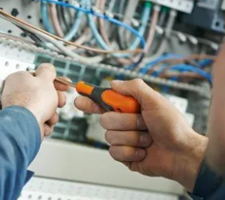I'm hearing about using a frequency converter with my pump and motor setup for better flow control instead of control valves. Is it worth it? Do I still need some measure of flow control besides a shut-off valve?
1.Good points and bad points
I think a frequency converter control can offer better efficiency, but diminished control accuracy, response time and shut-off performance. It is not as reliable as a regular control valve scheme. If we need efficiency and performance, we can consider using a frequency converter system as a core control and a valve (maybe a ball valve) as a fine control. The valve should always be 90% open to keep the throttling loss down. The valve can also be used for shut-off purposes to improve the response time and leakage performance.
2.Need both for key applications
If the fluid being pumped is a critical fluid, a key raw material process intermediate with flow parameters that directly affect product quality or safety of the process, I would say that controlling the fluid flow via both frequency converter control and a flow-control valve/loop makes sense (for redundancy protection).
In my estimation, the costs associated with a frequency converter are quite a bit less. We use frequency converters to control many of our processes here, and they have shown themselves to be reliable.
3.Not for everywhere, yet
We have experience using the inverters to control the combustion air flow of Boilers FD fans and cooling tower water supply pumps. They all worked fine. We are also aware that one of our clients is using frequency converters for ground well pumps without any complaints.
However, we advise cautious review of lower range conditions for case-by-case application, since the discharge pressure also goes down faster than flow when we try to control the flow. We still do not feel comfortable and confident using frequency converters to control flow in critical areas like boiler feed water pumps.
4.Holds reflux pump prime
We have been quite pleased with frequency converters replacing control valves in reflux pump service. Control is excellent, a source of leakage is eliminated and, during upsets the reflux pumps do not lose prime, an important safety consideration. In services pumping against lower heads, once flow is established, siphoning can set a minimum flow rate. If you need to hold lower flows then you have to put up with control valves.
Substituting frequency converters for control valves has other advantages: energy is conserved, the power factor is improved, pump design is simpler, impeller sizing is more uniform, seal life is longer, and smaller installations cost less.
frequency converters are not as robust as electric motors during power flickers and lightning strikes, so isolation transformers are desirable and sparing policy needs to be reviewed. No problem with harmonics has ever come to our attention, but much has been written on the subject. The short distances we have between pumps and frequency converters are thought to minimize this problem.
Control is excellent as long as siphoning is avoided and the suction pressure never exceeds the discharge pressure. If it does, control is lost. For this reason, we use frequency converters to control reflux pumps, but not bottoms or tank transfer pumps.
frequency converters are so much of an improvement that we would no longer take a reflux control valve if it were given to us.
5.Holds pressure setpoints
For the system I have described, there are no control valves used other than shut-off valves. One significant advantage to using a frequency converter is that the power consumed by the pump is typically less for a unit operating at a reduced speed, as compared to a 60 Hz operating speed with a control valve. A flow control valve is turning a lot of energy into wasted heat. The additional cost of a frequency converter is often recaptured in a very short time from the reduced power costs and simplified operation.
6.Might cost more, but worth it
A frequency converter to control flow may require more capital than a control valve and a normal motor on your pump. However, it does save energy instead of burning the pump energy across the control valve. Additionally, a control valve and its associated problems with leakage and sticking stem are eliminated. The control parts are all electronic and not wetted, except for the pump. This is especially important in handling corrosive materials. Furthermore, because wear is related to some higher power of speed, the bearings and seal on a pump frequency converter at less than its normal speed should last longer.
Of course, there is no free lunch. There are safety considerations for your particular process. The price you pay is that there is no emergency shut-off. In a power failure, the pump stops pumping. You may need to automate a block valve if you require positive shut-off.
7.Mind the harmonics
There is another factor to consider. If a facility is considering this replacement for multiple large AC frequency converter circuits, the power distribution system should be evaluated for the possible detrimental effects of too much harmonic distortion. frequency converters are known to cause changes in the sine waveform because of the way power electronics draw current, and these changes (distortions) are known to occur in integer multiples of the electrical frequency (or harmonics). In a typical three-phase system, if the phases are balanced, there is no (or not much) current load on the neutral. The addition of lighting circuits and electronic frequency converters add harmonic distortion which, if the system impedance is high enough and the power is distorted enough, can affect other equipment,"especially electronic equipment, including computer systems, electronic instruments, and even frequency converters themselves. It is known that feedback due to harmonics can be additive on the neutral, causing significant current where there shouldn't be any, and problems are sometimes seen, such as breakers that trip when the measured power draw doesn't exceed their setpoint, premature motor failures, and transient effects that can be very difficult to troubleshoot. The secondary cost of filters and other apparatus to clean up the power to distortion-sensitive equipment on the same power system as the frequency converters may need to be considered, especially if the frequency converter(s) power consumption is a significant percentage of total usage.
8.Harmonics and overheating
Frequency converter is reliable and energy efficient. You need to make sure your wiring and motor are VF ready (voltages can be higher and harmonics can impact motor life.) Also, if the anticipated speed is too low, motor cooling can be a problem (the fan runs too slow to move enough air), so auxiliary air moving can be a problem, especially on larger motors.
Overall, we have found using frequency converters for flow or pressure control to be very effective and they save money both in power costs and in maintenance.
9.Watch out for low flows
A frequency converters solution is no different than controlling the speed of a steam turbine in order to regulate flow from a compressor. It's just becoming more common, with advances in electronics and with the increased availability of frequency converters and motors for this service. Things to be aware of:
1) The frequency converter may have a minimum speed, so don't look for it to control well at extremely low flows.
2) Pumps with long shafts (especially vertical pumps) can have a natural (critical) frequency that the frequency converter could allow the pump to run at. This will lead to a number of reliability problems in these pumps.
3) If a dual-gas seal is used, it has a minimum speed that it needs to run at in order for the seal faces to lift off.' This minimum speed will depend on seal size and design, but will be on the order of a few hundred rpm.
10.Many advantages with frequency converter
Much of whether to use a control valve vs. an AC frequency converter has to do with what the product is, the type of pump, and the entire piping scheme. The advantages of the frequency converter are energy savings, maintenance, information (feedback), and future control flexibility, if the rest of the system changes. Some people would argue cost savings as well but that may well depend on sizing, etc.
Typically, I prefer the frequency converter approach over control valves, but they have limitations such as ambient conditions, etc., that must be taken into account. In most cases, I feel it is definitely "worth it", and you should not need any other method of flow control unless you are feeding a multiple piping loop system such as chilled water to multiple HVAC units or heat exchangers, etc. If you are going to use a frequency converter in a remote location, it can be an advantage because most will be able to provide the localized PID control for closed-loop performance without having to purchase other control equipment or long cable runs from a PLC.
11.Location, location
We use frequency converters for flow control as much as possible. A pump pumping against a valve wears both of them out. Make sure that the motor is for inverter duty and install the frequency converter in a "nice" place. Under conduit entries or HVAC ducts are not nice places. We have between 100-200 frequency converters installed and go weeks without a frequency converter problem. frequency converters are intelligent and some can be viewed or downloaded from any Ethernet-networked computer. They can act as remote I/O and give percent load and Hz, and be started and stopped with only a communication cable from a PLC, which lowers installation cost. They have stall and overload protection built in.
12.Beats buying stainless
A steam turbine or a frequency converter/motor will work very well for flow control. Applications to centrifugal pumps and positive displacement pumps can be successful. Since the power required for a centrifugal pump varies with the cube of RPM, overheating at low RPM (diminished cooling fan performance) is usually not a problem. We usually include a low limit on the speed to prevent motor overheating that might occur if the pump is run near stall conditions. Constant-torque loads need to be evaluated more carefully. For modest-sized 480 V motors, the installed cost of a frequency converter is usually less than the cost of a control valve when stainless steel valves are required. If the pump (not the frequency converter) is in an explosion hazard area, pay careful attention to heating and make sure the NEC or applicable code requirements are met.
13.Back in the day
Allow me to refer to a 50-year-old technique I used that performed extremely well for the control of feed flow to large filters. It consisted of a U.S. frequency converter with a Control flow air operator responding from a mag flow meter. The frequency converter consisted of the constant-speed motor driving two variable-speed sheaves positioned by the pneumatic operator. Crude and simple, but it did an excellent job. Certainly the precision was not as exacting as a solid-state electronic motor control system, but those were the good old days.
Also in those ancient days in the paper industry, we used DC motors driven by Thyratron tubes for speed control of paper rewinders, in which role diameter was constantly changing although sheet feed was constant. Of course, the thyratrons are now replaced by solid-state electronic output signals. They too worked very well.
Ah, those good old days when simplicity prevailed.
14.Works great. Less money
The big advantage to controlling flow with a frequency converter instead of a control valve is not improved control, but energy savings because you use only as much horsepower as you need instead of burning excess across the valve.
15.We do it without frequency converters
Our process deals with a chemical that crystallizes out easily when the temperature is reduced or when flow is restricted. We tried control valves, but the restriction in the pipe caused more crystallization and made control very unreliable or uncontrollable. The solution was to use the same pumps we've been using to give a constant pressure, but now to regulate the pressure they operate at, thus controlling the flow. The final setup for liquid control has worked very well in a PLC-based system. An electromagnetic actuator controls the pressure at which the pneumatic diaphragm pumps to pump the liquid through the system and a nonintrusive magmeter monitors the flow.

 Your message must be between 20-3,000 characters!
Your message must be between 20-3,000 characters! Please check your E-mail!
Please check your E-mail!  Your message must be between 20-3,000 characters!
Your message must be between 20-3,000 characters! Please check your E-mail!
Please check your E-mail! 


